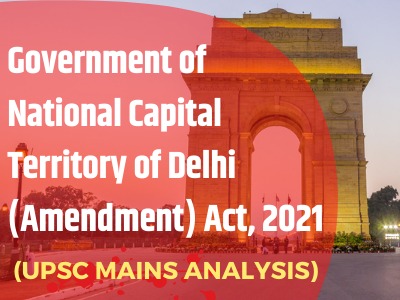
What is it about?
The act amends certain sections of the National Capital Territory of Delhi act 1991. It has revamped the role of Lt. Governor vis-a-vis the elected government of Delhi.
What are the features of the amendment?
- The term “government” in the National Capital Territory of Delhi now means the Lieutenant-Governor of Delhi.
- Grants discretionary powers to the L-Geven in matters where the Legislative Assembly of Delhi is empowered to make laws.
- The LG can “necessarily grant his opinion”, before the council of ministers take any cabinet decisions or any such decisions.
- The elected assembly or any committee of the assembly is now barred from making any rules for the effective functioning of the administration.
- The elected assembly or any of its committee is now barred from conducting inquiries pertaining to the administrative decisions.
Why the amendment?
- The Central government has pointed that the amendment will improve administrative efficiency and reduce technicalities resulting into frequent frictions.
- It will act as a source of additional opinion to the elected government in the form of LG advice.
Critical analysis of the amendment:
- Manner of legislation: the amendment is criticized for having not deliberated enough in both houses. No committee scrutiny was done to seek diverse opinions.
- Against the spirit of federalism: with LG now in a position to yield more executive powers, it is being perceived that the central government will have further control over the matters of the Delhi administration.
- Against the spirit of representative government: critics feel that with enhanced LG powers there will be more interference in the administration functioning, it will undermine the Delhi government in day-to-day matters. Already the 239 AA has given many centralizing powers to the center. With this amendment, the center went against the idea of representative government
- Governance deadlock: having witnessed tussles between LG and respective Chief Ministers of Delhi, the same can continue resulting in a slowdown in administration.
- Judicial burden: as witnessed in previous years, the executive tension between the LG and the elected Delhi government has resorted to judicial mediation. A similar judicial resort is expected in the future too.
- Statehood for Delhi: the long objective of Delhi being granted complete statehood has received a setback, through established protocols of working between the elected government and Central government through LG, the negotiated trust appears to be broken.
- Future of federalism: with the maturity of democracy, it is expected that centralizing tendencies reduce and more federal models of governance be witnessed. However, in the past 2 years with the conversion of the erstwhile state of J & K into union territories, the tussle between the LG and Chief Minister in Puduchchery, has raised further questions about the working equation between the UTs and Central government.
Supreme Court judgment 2018:
In the Government of NCT of Delhi vs. Union of India case, the SC held that LG concurrence on administrative matters is not an obligation to the elected government.
Way forward:
- It is expected that the amendment would be challenged in the Supreme Court. However the larger issue needs to be resolved, the power tussle will yield only negative and slow results for the people of Delhi, ultimately resulting in the failure of both the Centre and Delhi Government.
- It is thus necessary for the SC to take a middle path, certain sections like discretionary powers to LG in legislative matters and Government meaning LG needs to dilute.
Similarly, the Delhi elected government needs to work more in the nature of patient negotiations and not agitational politics as is being witnessed it the past few years.
